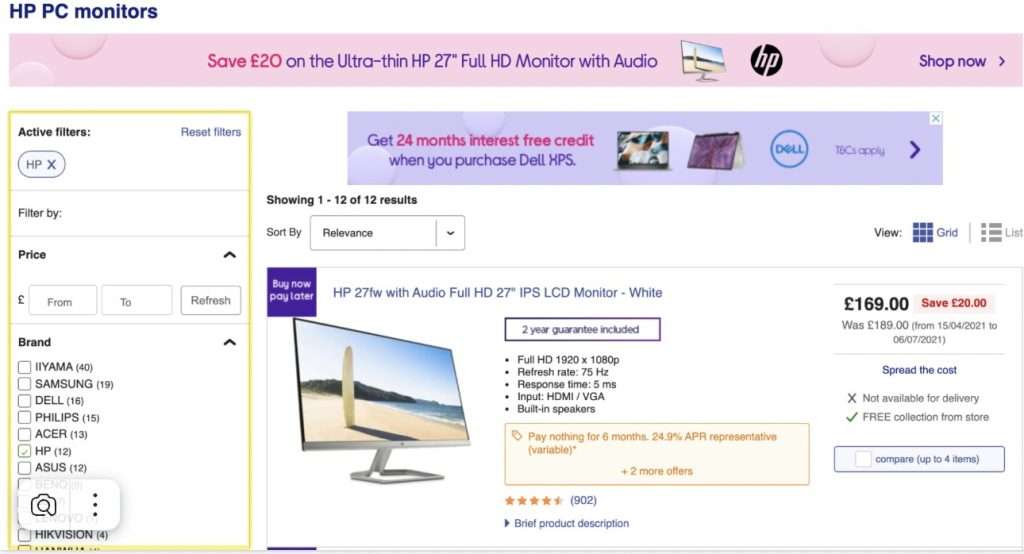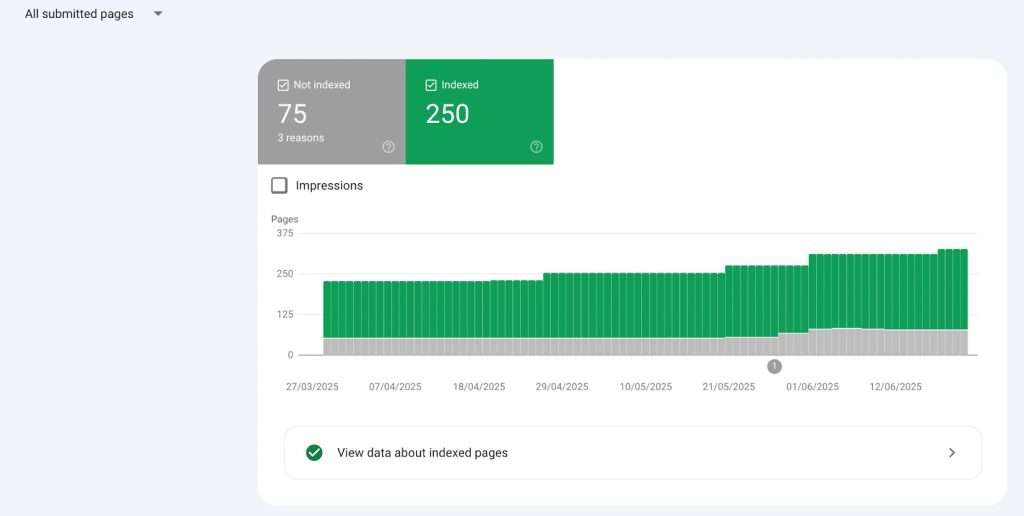Faceted navigation is a UX pattern that helps users discover specific listings on category pages by filtering content based on various attributes. Also known as faceted search or guided navigation, this system allows visitors to narrow down search results using multiple filters simultaneously – such as price range, brand, color, size, or material.
Think of faceted navigation as a sophisticated filtering system. When you shop on Amazon and filter products by brand, price, and customer ratings, you’re using faceted navigation. Each filter represents a “facet” that helps users find exactly what they need from thousands of options.
For ecommerce SEO, faceted navigation presents both opportunities and challenges. While it dramatically improves user experience by helping visitors find products faster, it can create serious technical SEO problems if implemented incorrectly. The system generates multiple URL variations for similar content, potentially causing duplicate content issues, wasting crawl budget, and diluting link equity.
The key to successful faceted navigation lies in balancing user needs with search engine requirements. When done right, it enhances both user satisfaction and search visibility. When done wrong, it can harm your organic performance and create indexing nightmares that take months to resolve.
Modern search engines understand the value of faceted navigation for user experience. However, they also penalize sites that create excessive duplicate content or waste crawl resources. This makes proper implementation crucial for maintaining both usability and SEO performance.
- How Faceted Navigation Works: Technical Implementation
- Faceted Navigation Examples Across Different Website Types
- Facets vs Filters: Understanding the Distinction
- SEO Risks and Problems Caused by Faceted Navigation
- How to Identify Faceted Navigation SEO Issues
- Solutions for Fixing Faceted Navigation SEO Issues
- Best Practices for SEO-Friendly Faceted Navigation
- Leveraging Faceted Navigation for Long-Tail SEO Traffic
- Auditing Your Faceted Navigation Implementation
- Advanced Faceted Navigation Strategies and Future Considerations
How Faceted Navigation Works: Technical Implementation
Faceted navigation functions through four main technical approaches, each with different SEO implications. Understanding these methods helps you choose the right implementation for your specific needs.
The first approach involves instant JavaScript updates without page reloads. Users select filters, and JavaScript immediately updates the visible content while keeping the same URL. This method provides smooth user experience but can create crawlability issues since URLs don’t change to reflect filter states.
Page reloads with updated listings represent the second method. Each filter selection triggers a new page load with updated URL parameters. This approach makes filter states crawlable but can slow user experience and create numerous indexable URLs.

Apply button functionality offers a third option. Users select multiple filters before clicking an “Apply” button to update results. This reduces the number of URL variations but can feel clunky for users accustomed to instant filtering.
New page loading creates the fourth approach. Each filter combination loads a completely new page with its own URL structure. This method provides clear URL patterns for SEO but requires careful management to prevent index bloat.
URL handling varies significantly across implementations. Some systems create no URL changes, others append parameters like “?color=red&size=large”, use hash fragments “#red-large”, or generate clean URLs like “/products/red-shoes-size-8/”. The chosen approach directly impacts crawlability, indexability, and user sharing capabilities.
Faceted Navigation Examples Across Different Website Types
Ecommerce sites showcase the most common faceted navigation implementations. Online retailers like Amazon, eBay, and specialized stores use filters for product attributes including color, size, brand, price range, customer ratings, and availability. These filters help shoppers navigate thousands of products efficiently.
Publishers and content sites employ faceted navigation for article filtering by publication date, author, topic category, content type (videos, articles, infographics), and reading time. News websites often combine geographic and temporal facets to help readers find relevant stories.
Real estate platforms utilize location-based facets including neighborhood, property type, price range, number of bedrooms, square footage, and amenities. Travel sites filter by destination, travel dates, hotel ratings, amenities, and price points.
Job listing sites implement facets for location, salary range, experience level, company size, remote work options, and industry sectors. Directory websites organize listings by geographic location, business category, ratings, and service types.
Library catalogs and educational platforms use subject matter, publication year, format type, language, and academic level as primary facets. These implementations demonstrate how faceted navigation adapts to different content types while serving the same core purpose.
Facets vs Filters: Understanding the Distinction
The distinction between facets and filters significantly impacts SEO strategy and implementation decisions. Understanding this difference helps prioritize which elements should generate indexable pages versus remaining as user-focused tools.
Facets represent attributes that should create new landing pages for search engines. These include product categories, brand names, material types, gender-specific products, color variations, and specific use cases. For example, “women’s running shoes” or “waterproof jackets” represent valuable facet combinations that users actively search for.
Filters serve as user-focused tools that shouldn’t create indexable pages. Price ranges, availability status, customer ratings, shipping options, and inventory levels fall into this category. These elements help users refine results but rarely represent search queries worth targeting.
Size filters present a special case requiring careful consideration. While “size 8 shoes” might generate search volume, “size 8 red shoes” typically doesn’t warrant a dedicated landing page. The key lies in analyzing actual search demand for specific combinations.
Geographic facets often blur the line between facets and filters. “Restaurants in New York” deserves indexing, while “restaurants within 5 miles” functions better as a filter. Search volume and user intent determine the appropriate treatment.
Free 7 days access to all tools. No credit card required!
Попробовать бесплатно
SEO Risks and Problems Caused by Faceted Navigation

Duplicate Content Issues
Faceted navigation creates multiple URLs with identical or nearly identical content, leading to duplicate content problems that can significantly impact search performance. When users apply filters, they often see the same products or information presented slightly differently, creating close copies of original pages.
This duplication causes keyword cannibalization where multiple URLs compete for the same search terms instead of consolidating ranking signals into stronger single URLs. Search engines struggle to determine which version deserves higher rankings, often resulting in lower positions for all variations.
The dilution of ranking signals represents another serious consequence. Instead of concentrating authority and relevance signals on one strong page, these signals spread across multiple weak variations. This distribution reduces the overall ranking potential for important product categories and reduces organic visibility.
Content similarity between filtered pages exacerbates these issues. A page showing “red shoes” and another showing “red shoes under $100” may differ by only a few products, creating substantial content overlap that search engines interpret as duplication.
Index Bloat and Crawl Budget Wastage
Faceted navigation can generate millions of indexable URLs with minimal unique content value, creating index bloat that overwhelms search engine resources. Large ecommerce sites often discover they have more indexed filter combinations than actual products, indicating serious efficiency problems.
Crawl budget wastage occurs when search engines spend valuable time crawling low-value faceted pages instead of focusing on important content. For large sites with thousands of products, this inefficiency can prevent new or updated content from being discovered quickly during peak seasons.
The creation of crawl traps represents a particularly serious problem. When faceted navigation allows unlimited filter combinations, search engine bots can become trapped crawling endless URL variations. Some sites generate billions of possible URL combinations from just hundreds of base pages.
Low-quality pages flood search indexes when faceted navigation creates URLs with minimal content differences. These pages provide little value to users but consume indexing resources that could be better allocated to meaningful content pages.
PageRank Dilution and Internal Linking Issues
Faceted navigation dilutes PageRank by creating numerous internal links that divide link equity among many URLs instead of concentrating it on important category and product pages. This distribution weakens the overall authority of critical landing pages.
Internal linking structures become complex and inefficient when faceted URLs receive equal treatment with primary pages. Important category pages must compete for link equity with countless filter combinations, reducing their potential to rank for competitive terms.
Crawl traps emerge when massive numbers of faceted URLs overwhelm search engine crawlers, causing them to miss important pages while exploring endless filter combinations. This problem particularly affects large sites during critical crawling periods.
Link equity distribution becomes unpredictable when users and external sites link to various filter combinations instead of canonical category pages. This scattered linking pattern prevents the concentration of authority needed for competitive rankings.
How to Identify Faceted Navigation SEO Issues
1.Conduct Site Search Analysis
- Use the site: search operator to identify index bloat
- Search “site:yourdomain.com” and review total results
- Look for unusual URL patterns with parameters
- Compare indexed pages with intended site size
2.Analyze Google Search Console Coverage
- Review indexed pages versus submitted pages
- Check “Indexed, not submitted in sitemap” section
- Identify crawl errors related to parameter URLs
- Monitor indexing trends over time

3.Review URL Parameter Patterns
- Document how filters combine in URLs
- Identify unlimited combination possibilities
- Check for parameter ordering consistency
- Map filter hierarchies and dependencies
4.Assess Content Duplication Levels
- Compare content across filter combinations
- Identify pages with minimal content differences
- Check for keyword cannibalization patterns
- Evaluate unique value proposition of filtered pages
Site Search and Google Search Console Analysis
Site search operators provide quick insights into potential faceted navigation problems. The site:yourdomain.com query reveals all indexed pages, often exposing unexpected filter combinations that shouldn’t be in search results.
Google Search Console coverage reports offer detailed views of indexing patterns. The difference between submitted and indexed pages can indicate faceted navigation creating unintended URLs. Large discrepancies suggest crawl budget waste on filter combinations.
Coverage errors often reveal faceted navigation issues through “Crawled – currently not indexed” reports. These pages represent crawl budget waste where search engines discovered filter URLs but deemed them unworthy of indexing.
Index trending data shows whether faceted navigation problems are growing. Sudden spikes in indexed pages often correlate with new filter implementations or changes to parameter handling systems.
Site Audit Tools and Advanced Detection Methods
Professional SEO tools provide comprehensive data on faceted navigation impacts through crawl analysis and indexability reports. These tools simulate search engine behavior to identify crawler traps and inefficient URL patterns.
Indexability distribution charts reveal the proportion of pages that should be indexed versus those creating bloat. Healthy sites show clear distinctions between valuable content and filter combinations.
URL pattern analysis identifies systematic faceted navigation problems through automated detection of parameter structures. These patterns often reveal infinite combination possibilities that need immediate attention.
Crawl data interpretation helps identify faceted navigation efficiency issues by comparing crawl frequency with traffic generation. Pages crawled frequently but generating no traffic represent clear optimization opportunities.
Solutions for Fixing Faceted Navigation SEO Issues

Canonical Tag Implementation
Canonical tags consolidate link signals from faceted pages to main category pages, directing search engines toward preferred URL versions while maintaining user experience. Proper implementation requires careful consideration of which pages should be canonical sources.
HTML canonical tags appear in page headers: <link rel=”canonical” href=”https://example.com/shoes/” />. These tags tell search engines that filtered variations should pass their authority to the main category page instead of competing for rankings.
HTTP header canonicals offer alternative implementation for dynamic pages: Link: <https://example.com/shoes/>; rel=”canonical”. This approach works well for sites where HTML modification is difficult or when dealing with non-HTML resources.
Canonical tag limitations include Google’s discretion to ignore suggestions when they conflict with other signals. Strong internal linking, user behavior data, and consistent site architecture support canonical tag effectiveness. Self-referencing canonicals should always be used on pages you want indexed.
Robots.txt and Crawl Blocking
Robots.txt files prevent search engines from crawling specific faceted URLs by blocking access to parameter patterns. This approach works best when you have clear URL structures and want to completely eliminate crawling of filter combinations.
Parameter blocking uses wildcard patterns to target multiple URLs: Disallow: /*?color= blocks all URLs with color parameters. Directory-based blocking targets specific sections: Disallow: /products/filters/ prevents crawling of filter subdirectories.
Robots.txt effectiveness depends on consistent URL patterns and proper implementation. However, this method only prevents crawling, not indexing. Previously indexed pages may remain in search results even after robots.txt blocking.
The limitations of robots.txt include inability to control indexing of already-discovered URLs and potential loss of link equity from blocked pages. Combining robots.txt with other methods provides more comprehensive control over faceted navigation.
Nofollow Links and Internal Link Management
Nofollow attributes on faceted navigation links prevent crawl waste and link equity dilution by telling search engines not to follow specific filter combinations. This targeted approach allows control over which faceted pages receive crawler attention.
Strategic nofollow implementation focuses on low-value filter combinations while preserving crawling of valuable long-tail variations. Price filters, availability options, and sorting parameters typically warrant nofollow treatment, while brand and category combinations may deserve crawling.
Google treats nofollow as a hint rather than a directive, meaning crawlers may still follow nofollowed links in some cases. However, nofollow significantly reduces the probability of crawling and helps prioritize valuable content over filter combinations.
Link equity management through selective nofollow application helps concentrate authority on important pages while maintaining user experience. This approach requires ongoing monitoring to ensure valuable faceted pages aren’t inadvertently blocked from receiving link signals.
Noindex Tags and Definitive Indexing Control
Noindex implementation provides definitive control over which faceted pages appear in search results through meta robots tags: <meta name=”robots” content=”noindex, follow”>. This approach allows crawling for discovery while preventing indexing of duplicate content.
X-Robots-Tag headers offer server-level noindex control: X-Robots-Tag: noindex, follow. This method works well for dynamic pages and situations where HTML modification is challenging or impossible.
The trade-offs of noindex include loss of ranking signal consolidation since noindexed pages can’t pass authority through canonical tags. However, noindex provides definitive protection against duplicate content penalties and index bloat.
Long-term considerations for noindex usage include potential removal of internal links to noindexed pages over time. Search engines may eventually stop crawling pages that are consistently noindexed, affecting discovery of new content through internal linking.
Best Practices for SEO-Friendly Faceted Navigation
AJAX Implementation and URL Management
AJAX-based faceted navigation offers optimal user experience by updating content without page reloads while maintaining SEO compatibility through proper URL management. This approach requires careful implementation to balance user experience with crawler accessibility.
JavaScript implementation should update URLs using the History API to reflect filter states while avoiding internal link creation. Hash parameters provide URL shareability without creating crawlable links: /products#color=red&size=large.
URL shareability remains crucial for user experience and social media sharing. Clean parameter implementation allows filter state preservation while maintaining canonical tag effectiveness for SEO purposes.
Hash parameter usage helps avoid crawl issues while preserving functionality. However, ensure that canonical tags point to clean URLs without hash fragments to maintain proper signal consolidation.
Creating Strategic Crawl Paths
Strategic crawl paths balance the prevention of crawl waste with ensuring important long-tail variations remain discoverable through editorial curation and controlled internal linking.
Sub-navigation links provide controlled access to valuable faceted pages without creating systematic crawl traps. Editorial teams can manually link to high-value filter combinations while avoiding automatic generation of all possible variations.
Indexable facet selection requires analysis of search demand, competition levels, and content uniqueness. Focus on combinations that represent genuine search queries rather than system-generated possibilities.
Editorial control over faceted page discovery helps maintain crawl efficiency while capitalizing on long-tail opportunities. This approach requires ongoing management but provides sustainable results without technical complexity.
URL Structure and Technical Implementation
Optimal URL structures for faceted navigation balance clean presentation with technical functionality. Fixed URLs provide better SEO signals than parameter-based approaches but require more development effort.
Query parameter handling requires consistent ordering to prevent duplicate URLs: always use /products?brand=nike&color=red instead of varying parameter sequences. URL canonicalization handles parameter order variations automatically.
Fixed URL creation provides superior SEO benefits through clean paths like /products/nike-red-shoes/ but requires comprehensive planning and development resources. This approach works best for limited, high-value filter combinations.
Platform limitations often determine implementation possibilities. Many ecommerce systems provide built-in parameter handling, while custom solutions offer more control over URL structures and SEO optimization.
Leveraging Faceted Navigation for Long-Tail SEO Traffic
Identifying Long-Tail Keyword Opportunities
Long-tail keyword research reveals valuable opportunities within faceted navigation systems. Tools like Rush Analytics’ Keyword Search Volume Checker help identify specific combinations worth targeting through dedicated landing pages.
Search volume analysis for filter combinations uncovers hidden traffic potential. While “shoes” may be highly competitive, “waterproof hiking boots for women” could represent achievable ranking opportunities with commercial intent.
The 99.84% of keywords receiving fewer than 1,000 monthly searches represent significant cumulative opportunity. Faceted navigation can capture this long-tail traffic efficiently when implemented strategically rather than comprehensively.
Competitive analysis reveals which filter combinations competitors successfully target, providing insights for strategic faceted page development. Gap analysis identifies untapped opportunities within your market segment.
Commercial intent evaluation helps prioritize faceted pages based on conversion potential rather than search volume alone. Users searching for specific product combinations often demonstrate higher purchase intent than general category browsers.
Strategic Facet Page Optimization
Faceted page optimization requires unique content creation, proper meta tag implementation, and technical SEO considerations. Automated systems can handle basic optimization while editorial teams focus on high-value pages.
Meta tag optimization for faceted pages should reflect specific filter combinations while avoiding keyword stuffing. Dynamic title generation can create relevant, unique titles for each combination: “Red Nike Running Shoes – Size 8-12 Available”.
Unique content creation presents the biggest challenge for faceted page optimization. Product descriptions, buying guides, and comparison content help differentiate filtered pages from their parent categories.
XML sitemap inclusion for valuable faceted pages helps ensure discovery while excluding low-value combinations. Prioritize faceted pages with search demand and unique content value for sitemap inclusion.
Header tag optimization should reflect filter combinations naturally: H1 tags might combine product category with filter attributes, while H2 tags organize product listings and supplementary content.
Auditing Your Faceted Navigation Implementation
Regular Crawl Analysis and Monitoring
Regular site crawling reveals faceted navigation performance and identifies emerging issues before they impact organic visibility. Automated monitoring helps track URL counts, indexation patterns, and crawl efficiency over time.
Crawl frequency analysis compares how often search engines access faceted pages versus their traffic generation. Pages crawled frequently but generating minimal traffic represent optimization opportunities or candidates for crawl blocking.
URL monitoring tracks total faceted URLs accessible to crawlers and trending patterns. Sudden increases often indicate new filter implementations or changes to parameter handling systems that need evaluation.
Content duplication tracking identifies faceted pages with excessive similarity that may trigger duplicate content penalties. Regular analysis helps maintain healthy content diversity across filter combinations.
Performance metrics should include crawl budget utilization, index bloat ratios, and traffic generation efficiency. These measurements guide optimization priorities and resource allocation decisions.
Performance Analysis and Traffic Evaluation
Traffic analysis identifies which faceted pages contribute meaningful organic visibility versus those consuming resources without benefit. This evaluation guides strategic decisions about which filters to maintain, optimize, or eliminate.
Active page identification separates valuable faceted URLs from crawl budget waste. Pages generating consistent organic traffic deserve optimization investment, while inactive pages may warrant noindex treatment or crawl blocking.
Conversion tracking for faceted pages reveals their business impact beyond traffic generation. High-converting filter combinations merit additional optimization even with moderate traffic levels.
User behavior analysis shows how visitors interact with faceted navigation and whether filter combinations align with user needs. High bounce rates on specific filter combinations may indicate poor content matching or user experience issues.
Search console data provides insights into which faceted pages Google considers valuable through impression and click data. Pages with high impressions but low clicks may need content or meta tag optimization.
Advanced Faceted Navigation Strategies and Future Considerations
The evolution of faceted navigation continues as search engines become more sophisticated in handling dynamic content and user experience requirements change. Understanding future trends helps prepare strategies that remain effective as technology advances.
User-generated facets present both opportunities and risks. While allowing users to create custom filters can improve satisfaction, it also creates unlimited URL combinations that can quickly overwhelm indexing systems. Successful implementation requires strict controls and search demand validation.
Site search integration with faceted navigation provides valuable data about user needs and preferred filter combinations. Internal search analytics reveal which combinations users seek but current facets don’t provide, guiding strategic expansion decisions.
Mobile optimization becomes increasingly critical as mobile traffic dominates. Faceted navigation must function effectively on small screens while maintaining SEO compatibility. Progressive web app features can enhance mobile faceted navigation without compromising search visibility.
Voice search and AI agents will likely change how users interact with faceted navigation. Natural language queries may bypass traditional filter interfaces, requiring adaptation of faceted systems to support conversational search patterns.
Search engine treatment of JavaScript-rendered content continues evolving, potentially offering new possibilities for faceted navigation implementation. However, current best practices should remain foundational until new approaches prove reliable.
Machine learning applications in ecommerce may personalize faceted navigation based on user behavior, creating unique filter combinations for different visitors. These developments require careful consideration of SEO implications and canonical URL strategies.
FAQs
What is faceted navigation in SEO?
Faceted navigation is a filtering system that helps users narrow down search results using multiple attributes simultaneously, such as price, brand, or color. It improves user experience but can create SEO challenges through duplicate content and crawl budget waste if not properly managed.
What are the benefits of faceted navigation?
Faceted navigation improves user experience by helping visitors find specific products quickly, reduces bounce rates, and can capture long-tail search traffic. It also enables better internal linking and can boost conversion rates through more targeted product discovery.
What is an example of a faceted search?
Amazon’s product filtering system exemplifies faceted search. Users can simultaneously filter electronics by brand (Apple), price range ($100-500), customer ratings (4+ stars), and shipping options (Prime eligible), with each selection narrowing the displayed results.
What is the difference between filtered search and faceted search?
Filtered search typically involves sequential filtering where one filter affects available options for subsequent filters. Faceted search allows independent selection of multiple attributes simultaneously, with each facet operating independently to create comprehensive filtering combinations.






